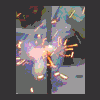Its nothing new or revalutionary I have to admit but rather a modification of alany 's bridgeless ematch composition found on here and his website. Ive removed the lampblack due to it being unnececcery now as there bridged and replaced it with some extra Antimony trisulphide and some K Benz as an aid to flame production. It now stands at:
65 K Chlorate
11 K Benz
21 Antimony Trisulphide
3 NC POWDER
all are ground seperately but for the NC Powder and mixed WET to a syrup like smooth paste and the ematch head (tutorial to follow) is dipped.
They dry hard though Im going to do some more testing with higher amounts of NC powder as you can still damage the head with rough handling. This is likely to make the head pop when ignited though so I will see.
They give a small ping pong ball sized globe of white flame when ignited with a lot of heat and ignite as good as instantly though I still think I will be better off with thinner nichrome than the 40swg I curently have as on auto fire my remote firer only sends current for a small space of time and some just dont fire when using it. Not had any failures at all yet as any that didnt fire on the auto feature fired after when I used the single fire system.
AAAAAAGGGGHHHHHH!!!!!!! had a look at the composition this evening and found it to have turned to a jelly! even with more acetone it doesnt seem willing to re emulsify so another set of experiments to come. Im guessing its some rection involving the K benz as no one has mentioned anything before re the antimony tri or K chlorate doing this in an NC laquer before.
Edited by cooperman435, 06 January 2008 - 05:48 PM.






















